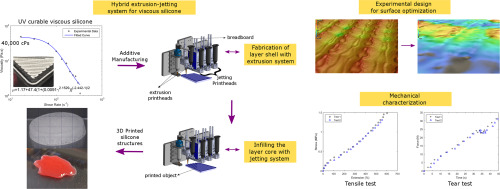当前位置:
X-MOL 学术
›
Mater. Des.
›
论文详情
Our official English website, www.x-mol.net, welcomes your feedback! (Note: you will need to create a separate account there.)
A hybrid additive manufacturing method for the fabrication of silicone bio-structures: 3D printing optimization and surface characterization
Materials & Design ( IF 8.4 ) Pub Date : 2018-01-01 , DOI: 10.1016/j.matdes.2017.10.051 Farzad Liravi , Ehsan Toyserkani
Materials & Design ( IF 8.4 ) Pub Date : 2018-01-01 , DOI: 10.1016/j.matdes.2017.10.051 Farzad Liravi , Ehsan Toyserkani

|
Abstract The incremental trend in the practical applications of Additive Manufacturing (AM) brings up the challenge of developing novel methods for the fabrication of new materials. Thermoset polymers such as silicone are considered challenging materials in terms of the AM adoption. Printing silicone at a high speed may revolutionize multiple industries, specifically the medical sector. In this paper, a hybrid system that combines material jetting and material extrusion AM processes will be introduced. This method is not only capable of printing the non-Newtonian viscous silicone, but also increases the fabrication velocity between 10 to 20 times compared to the regular extrusion methods. Statistical optimization methods are employed to explore the optimum range of input parameters with the goal to maximize the 3D printing resolution, and improve the surface quality of 3D printed features. Finally, the working principle of the hybrid manufacturing method will be explained based on the surface characterization results.
中文翻译:

用于制造有机硅生物结构的混合增材制造方法:3D 打印优化和表面表征
摘要 增材制造 (AM) 实际应用的增长趋势带来了开发新材料制造新方法的挑战。就 AM 采用而言,热固性聚合物(如硅树脂)被认为是具有挑战性的材料。高速打印硅胶可能会彻底改变多个行业,尤其是医疗行业。在本文中,将介绍一种结合材料喷射和材料挤出 AM 工艺的混合系统。这种方法不仅能够打印非牛顿粘性硅胶,而且与常规挤出方法相比,制造速度提高了 10 到 20 倍。采用统计优化方法探索输入参数的最佳范围,以最大化 3D 打印分辨率,并提高 3D 打印特征的表面质量。最后,将根据表面表征结果解释混合制造方法的工作原理。
更新日期:2018-01-01
中文翻译:

用于制造有机硅生物结构的混合增材制造方法:3D 打印优化和表面表征
摘要 增材制造 (AM) 实际应用的增长趋势带来了开发新材料制造新方法的挑战。就 AM 采用而言,热固性聚合物(如硅树脂)被认为是具有挑战性的材料。高速打印硅胶可能会彻底改变多个行业,尤其是医疗行业。在本文中,将介绍一种结合材料喷射和材料挤出 AM 工艺的混合系统。这种方法不仅能够打印非牛顿粘性硅胶,而且与常规挤出方法相比,制造速度提高了 10 到 20 倍。采用统计优化方法探索输入参数的最佳范围,以最大化 3D 打印分辨率,并提高 3D 打印特征的表面质量。最后,将根据表面表征结果解释混合制造方法的工作原理。



























 京公网安备 11010802027423号
京公网安备 11010802027423号